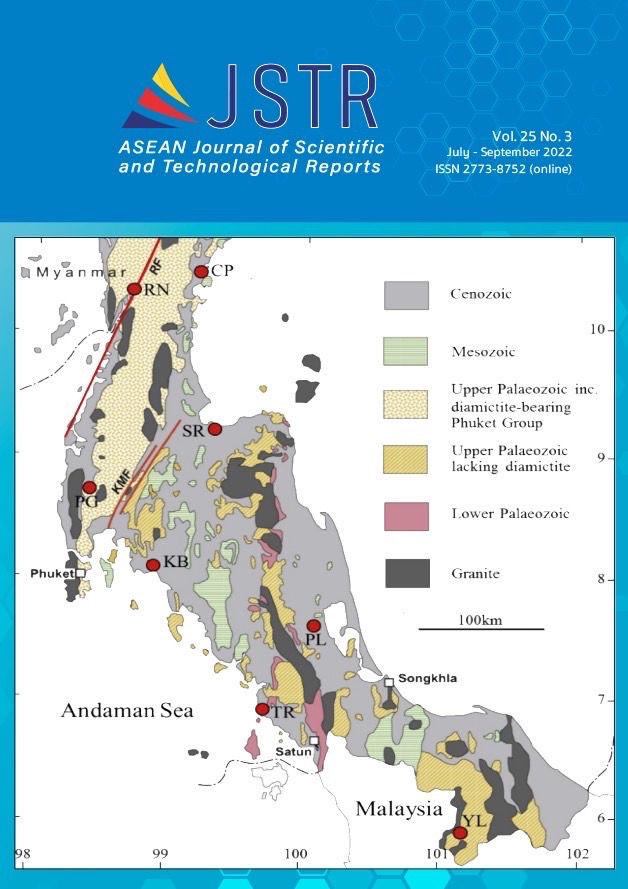Geothermometry in High-Temperature Reservoirs of the Geothermal Springs in Southern Thailand: Insights from Cations and Silica Geothermometers
Main Article Content
บทคัดย่อ
Geothermal springs have provided a unique opportunity to study the geothermal system of geological processes. A reservoir temperature estimation based on the chemical geothermometers is vitally essential for assessing the exploration and development of geothermal resources. The paper represents the various techniques of geothermometers with comparisons between the silica (quartz and chalcedony) and the cation geothermometers (Na–K–Ca and K–Mg) for the high exit temperature (temp. ≥55°C) of geothermal springs in southern Thailand. The Na–K–Ca geothermometer presented more elevated reservoir temperatures than the K–Mg, silica and chalcedony geothermometers, about 20–30◦C. The preliminary assumed difference between the geothermometers may indicate that the shallow subsurface conditions are mixed with groundwater
Article Details

อนุญาตภายใต้เงื่อนไข Creative Commons Attribution-NonCommercial-NoDerivatives 4.0 International License.
เอกสารอ้างอิง
Ngansom, W.; Dürrast, H. Geochemical Characterization of Hot Spring Waters from Southern Thailand as The Base for Geothermal Energy Utilization. Environment Asia. 2021, 14, 37–49.
Ngansom, W.; Pirarai, K.; Dürrast, H. Geological setting and hydrogeothermal characteristics of the Kapong non-volcanic hot spring area in Southern Thailand. Geothermics. 2020, 85, 101746.
Ngansom, W.; Dürrast, H. Assessment and Ranking of Hot Springs Sites Representing Geothermal Resources in Southern Thailand using Positive Attitude Factors. Chiang Mai Journal of Science. 2019, 46, 592–608.
Ngansom, W.; Dürrast, H. Saline hot spring in Krabi, Thailand: A unique geothermal system. Society of Exploration Geophysicists. 2016, 1949–4645.
Ngansom, W.; Dürrast, H. Integrated geoscientific investigations of the Phang Nga geothermal system, southern Thailand. Society of Exploration Geophysicists. 2017, 5427– 5431.
Fournier, R.O.; Rowe, J.J. Estimation of underground temperatures from the silica content of water from hot springs and wet- steam wells. American Journal of Science. 1966, 264, 685–697.
Fournier, R.O.; Truesdell, A.H. An empirical Na-K-Ca geothermometer for natural waters. Geochimica et Cosmochimica Acta. 1913, 31, 515–525.
Fournier, R.O. Chemical geothermometers and mixing models for geothermal systems. Geothermics 1977, 5, 41–50.
Fournier, R.O. A method of calculating quartz solubilities in aqueous sodium chloride solutions. Geochimica et Cosmochimica Acta. 1983, 47, 579–586.
Baioumy, H.; Nawawi, M.; Wagner, K.; Arifin, M.H.J. Geochemistry and geothermometry of non-volcanic hot springs in West Malaysia. Journal of Volcanology and Geothermal Research. 2015, 290, 12–22.
Dávalos-Elizondo, E.; Atekwana, E.A.; Atekwana, E.A.; Tsokonombwe, G.; Laó-Dávila, D.A. Medium to low enthalpy geothermal reservoirs estimated from geothermometry and mixing models of hot springs along the Malawi Rift Zone. Geothermics. 2021, 89, 101963.
Li, J.; Zhang, L.; Ruan, C.; Tian, G.; Sagoe, G.; Wang, X. Estimates of reservoir temperatures for non-magmatic convective geothermal systems: Insights from the Ranwu and Rekeng geothermal fields, western Sichuan Province, China. Journal of Hydrology. 2022, 609, 127668.
Mao, X.; Dong, Y.; He, Y.; Zhu, D.; Shi, Z.; Ye, J. The effect of granite fracture network on silica-enriched groundwater formation and geothermometers in low-temperature hydrothermal system. Journal of Hydrology. 2022, 609, 127720.
Huang, Y. H.; Liu, H. L.; Song, S. R.; Chen, H. F. An ideal geothermometer in slate formation: A case from the Chingshui geothermal field, Taiwan. Geothermics. 2018, 74, 319-326.


